When you think of a goose, you may imagine a large waterbird that resembles both a duck and a swan.
However, geese can come in a wide variety of colors and sizes. There are many species with unique looks.
If you’re looking to raise a beautiful goose in your farm or backyard, the Sebastopol goose is a great option.
Whether you’re a goose lover or a budding homesteader, keep reading for all the information you need to know about this special breed.
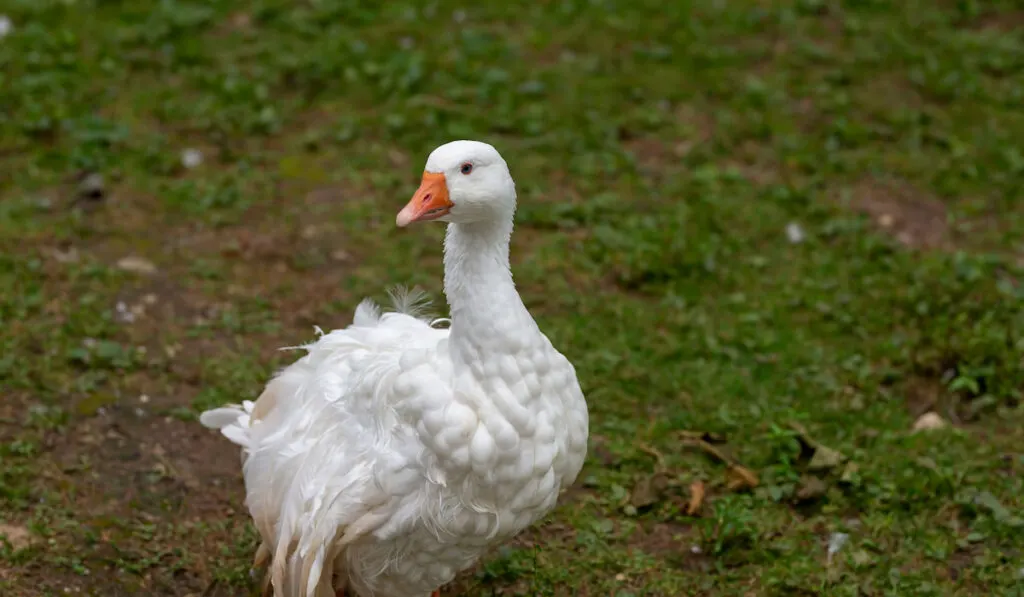
Table of Contents
History and Origin
The Sebastopol goose is not a new breed. Its origins can be traced back to 1860, when it was first brought to England from southeastern Europe.
There are two theories on how this goose came into existence. It was first thought that this species was originally developed in Central Europe, specifically along the Danube and the Black Sea.
But further evidence suggests that the Sebastopol goose hails from the Crimean Peninsula, located on the northern coast of the Black Sea.
The Sebastopol goose, named after a port on the Black Sea, was developed from the wild European Greylag goose.
The Sebastopol goose was known by many other names, such as Danubian goose in Ireland and Struppgans or Lockengans in Germany, which translates to “unkempt goose” and “curl goose”.
This breed arrived in Ireland in 1863, where it started to become famous and spread to other regions across the globe.
The global population of this breed is estimated today at less than 5,000. Hence, this bird is categorized as an endangered species by the American Livestock Breeds Conservancy.
What makes the Sebastopol goose truly interesting is that you can raise this bird for many different purposes, including meat, eggs, and aesthetic value.
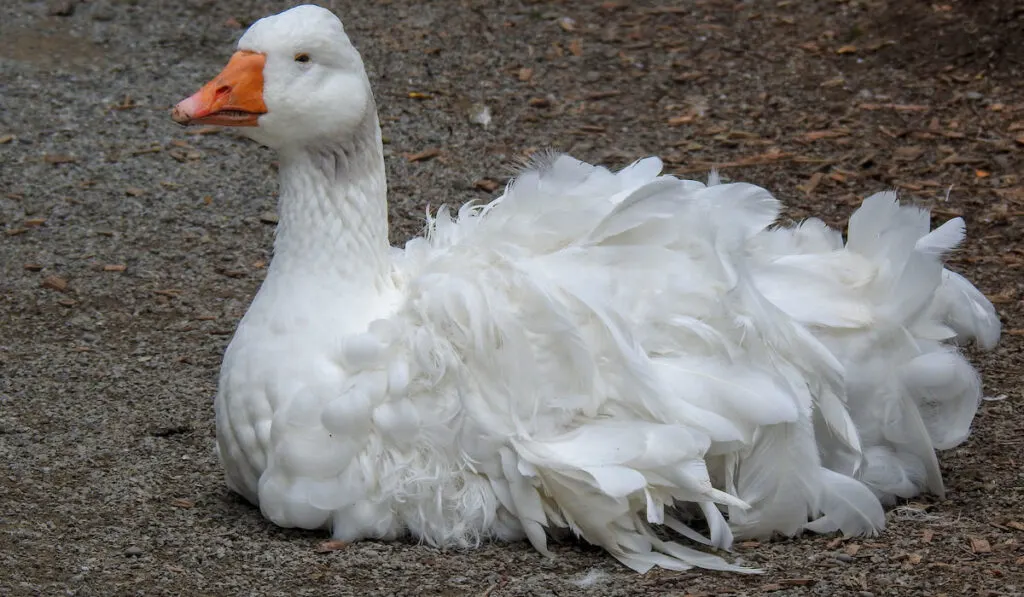
Physical Characteristics
You can easily spot a Sebastopol goose by the beautiful curly feathers that cover its entire body.
From the neck up to its round head, its feathers are much shorter and softer. In some cases, these feathers can be grayish-brown.
This white goose also has a bright orange beak, blue eyes, and pinkish to light orange feet.
Hybrid varieties may also produce different feather colors, including buff, gray, and saddleback.
On average, a male goose or gander weighs 12 to 14 pounds, whereas a female weighs 10 to 12 pounds. This bird typically measures 24 to 50 inches long.
Goslings are slightly different, with yellowish-gray feathers. As they mature and reach twenty weeks of age, most of these gray feathers will shed, before turning completely white.
You can find two Sebastopol variants, which are frizzle and smooth-breasted types. This classification was made based on feather texture.
The frizzle Sebastopol has curly, bush-like, thick feathers covering its body.
Meanwhile, the smooth-breasted Sebastopol does not grow curly feathers on its chest, but only on its wings, sides, and lower and upper body parts.
Temperament and Personality
Aside from being physically attractive, many traits make the Sebastopol goose a favorite of farmers and breeders.
The Sebastopol goose is friendly, quiet, and easy to handle.
Since it is not a hostile breed, you can keep it with other animals.
The Sebastopol goose also gets along well with adults and children. This is why it makes such a great backyard pet.
In addition, the female goose has a strong motherly instinct toward its goslings. These geese can even care for the young of other bird species!
If you choose to have a free-range Sebastopol goose, you don’t have to worry about building high fences or monitoring this bird closely.
The Sebastopol goose usually doesn’t roam far from its home. However, you still need to build good housing to protect this bird from predators.
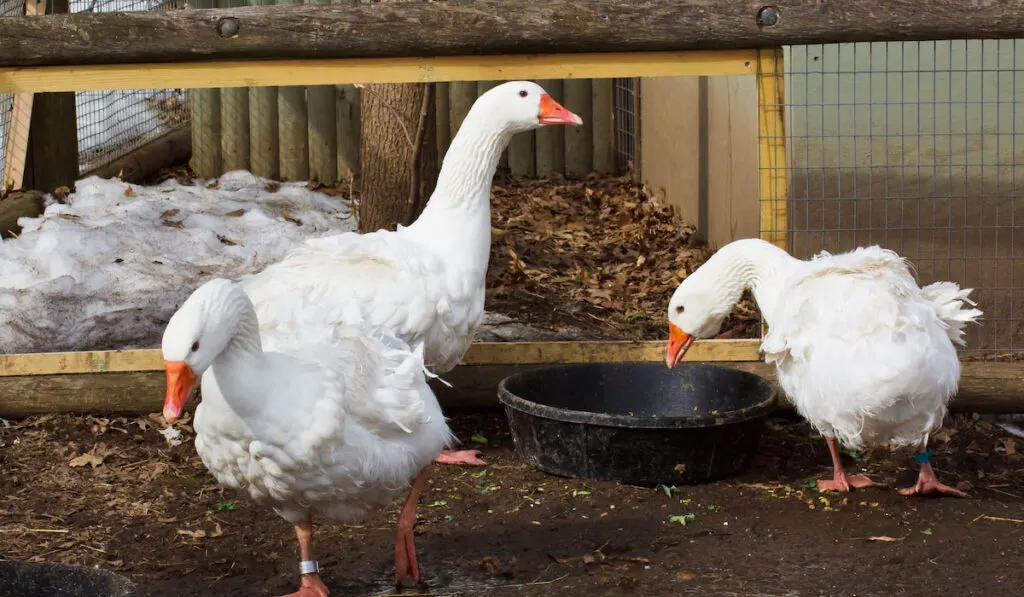
Diet and Feeding
The Sebastopol goose is not a picky eater. In fact, feeding this bird is fairly easy.
You can feed this omnivorous bird seeds, grasses, grains, and small insects.
If you raise the Sebastopol goose for its meat, you can feed it protein-rich pellets. The same thing goes for goslings, who need a lot of protein to grow properly.
Be careful when raising a Sebastopol goose in a cold climate, as it can be quite challenging.
Since extreme cold can harm or even kill this bird, don’t let it roam freely in low temperatures.
Additionally, cold weather will force this bird to produce more energy and heat. You will need to provide Sebastopol geese with carbohydrate-rich feed or pellets to keep its body warm.
In normal weather, you can let this bird roam with little to no monitoring.
Since the Sebastopol goose is an excellent forager, it won’t have any problems looking for food, such as worms, insects, and other invertebrates.
You may also feed the Sebastopol goose healthy treats, like cooked potatoes and carrots, cabbage, cauliflower, lettuce, and other vegetables.
Finally, ensure that your goose is properly hydrated.
Keep its container clean and regularly replace the water inside to prevent the bird from drinking contaminated water.
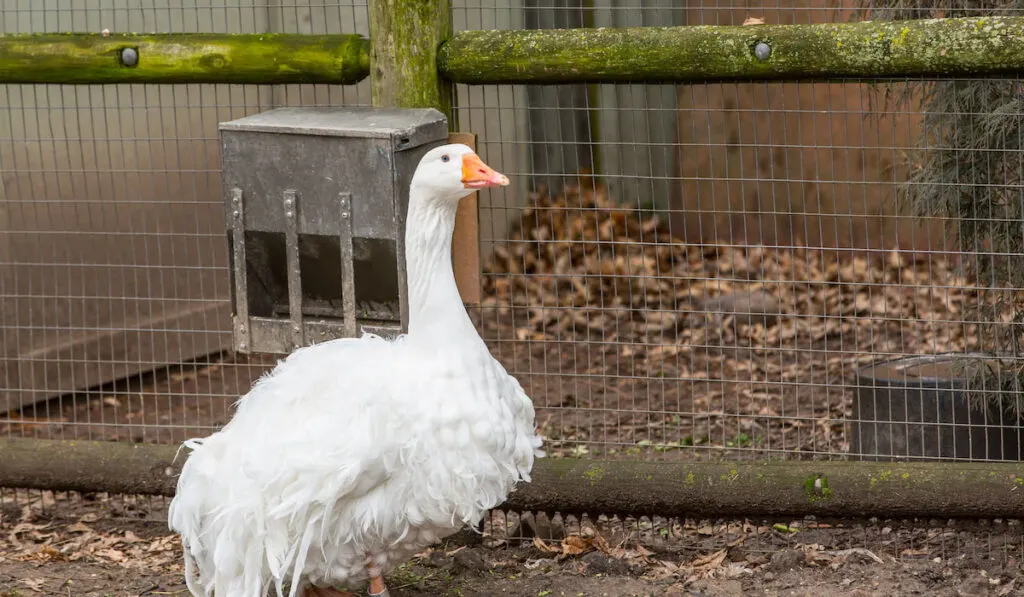
Lifespan and Health Issues
On average, a healthy Sebastopol goose can live 20 to 25 years.
The most important thing when raising a Sebastopol goose is to take care of its physical needs and hygiene.
Since this bird has curly and thick feathers, dirt, debris, and even leftover feed can easily get stuck in them. To avoid this, try to clean its living space once or twice a week.
You can also place hay, dried grass, or wood shavings for this bird to keep its body clean.
When a Sebastopol goose is in a healthy environment, it rarely gets sick. However, it can still be prone to some health issues.
Worms
Many types of worms can affect birds. However, the two most common worms that affect the Sebastopol goose are roundworms and hookworms.
These organisms are active parasites that live by draining and sucking the blood out of their hosts’ bodies.
The first step to preventing worm infestation is good hygiene.
Be sure to keep their living space clean. However, deworming is an effective way of handling this problem when prevention has failed.
Parasite Infestation
Ectoparasites, such as mites and lice, can affect the Sebastopol goose by penetrating or burrowing deep into this bird’s skin.
They begin to suck the bird’s blood and steal all the nutrition from their host’s body. Some of the signs of parasite infestation in the Sebastopol goose are diarrhea and physical discomfort.
As always, maintaining proper hygiene should be your main priority to prevent this issue.
Cocciodiosis
Coccidiosis usually affects goslings more than adult geese. This disease is caused by the protozoan Coccidia that affects the gastrointestinal system of the infected birds.
Symptoms of coccidiosis in Sebastopol goose are bloody droppings, severe weight loss, ruffled feathers, and the inability to stand properly.
Always hire an avian vet to do a quick check-up if your goose suffers from Cocciodiosis.
Treatment should continue until the bird’s droppings are clear and normal-looking.
Fowl Cholera
This deadly and highly contagious bacterial disease can affect geese and other avian species. It can start from just a single bird, who then can infect the whole flock.
Symptoms of fowl cholera are ruffled feathers, loss of appetite, coughing, nasal and oral discharge, diarrhea, and sudden death.
The most important thing to do when your goose is affected by this disease is to separate it from your healthy birds.
Weight Problems
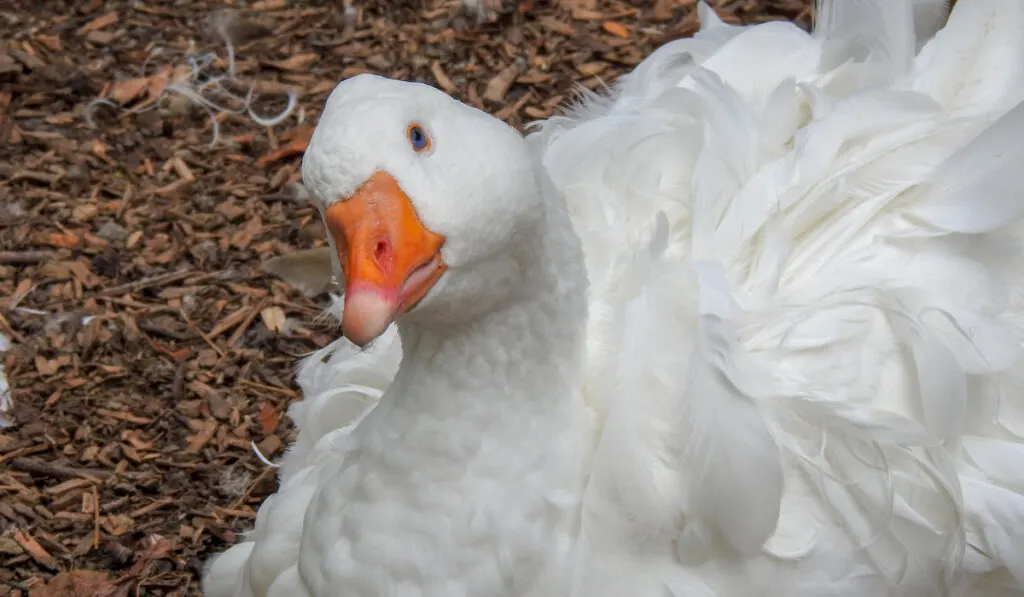
Obesity and other weight-related problems may affect the Sebastopol goose if you overfeed it.
Be sure to monitor its diet and encourage this bird to roam freely in an open field. This will keep it active and prevent issues that may arise from a sedentary lifestyle.
Botulism
Botulism is caused by neurotoxins from the bacteria Clostridium botulinum. This toxin can enter the goose’s body and affect its nervous system. One of the symptoms is neck paralysis.
Other signs of botulism in Sebastopol goose are respiratory problems, lethargy, loss of appetite, and paralysis of other body parts.
What Can You Raise the Sebastopol Goose For?
You can raise the Sebastopol goose for its meat, eggs, and aesthetic value.
However, this doesn’t mean that you can launch a large-scale poultry business by raising this breed. Raising the Sebastopol goose for its meat and eggs is only suitable for personal consumption.
The Sebastopol goose is not as big or heavy as other meat goose breeds or prolific layers that can produce hundreds of eggs per year.
However, this breed is definitely a good choice for a show bird.
How Many Eggs Does a Sebastopol Goose Lay?
The Sebastopol goose isn’t a prolific layer, laying between 25 to 35 eggs a year.
The eggs are white and four times larger than chicken eggs. Its laying season extends from February to April, and its eggs usually hatch after 30 days.
Rest assured that the female geese are protective mothers and will take good care of their young.
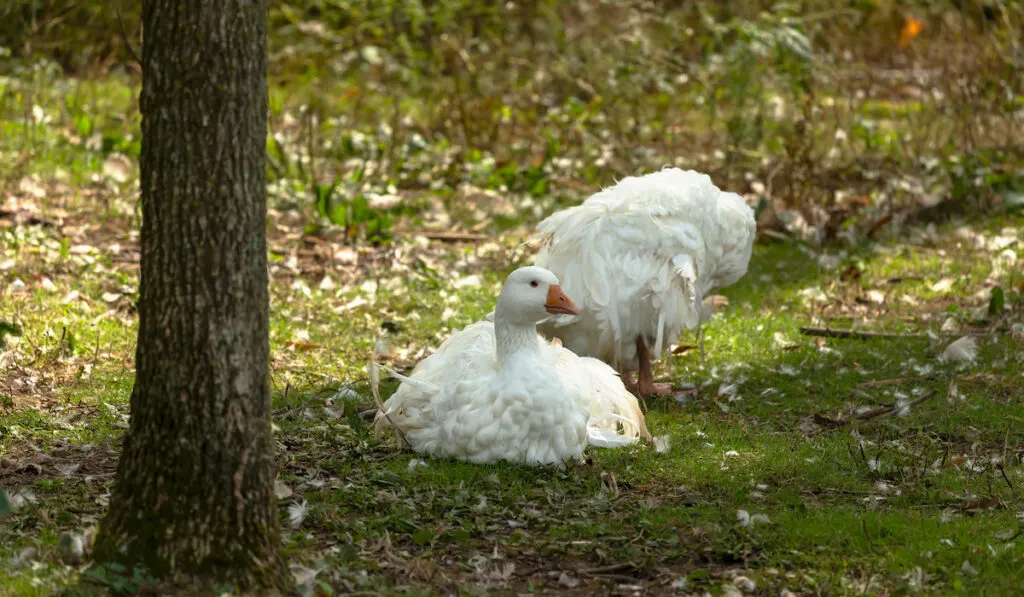
How Much Does a Sebastopol Goose Cost?
The price for a Sebastopol goose varies, depending on its age, color, and sex.
For instance, a sexed gray and dilute male gosling can cost $75 at Bushel and a Peck Hatchery, while a gander can cost $100 at Murray McMurray Hatchery.
The best thing to do is to scour the hatcheries in your area and ask for prices and available stock. Some hatcheries may ask you to reserve your spot or wait for the eggs to hatch.
Is the Sebastopol Goose Noisy?
A Sebastopol goose can produce a honk-like sound, especially when threatened. However, this breed is usually not very noisy.
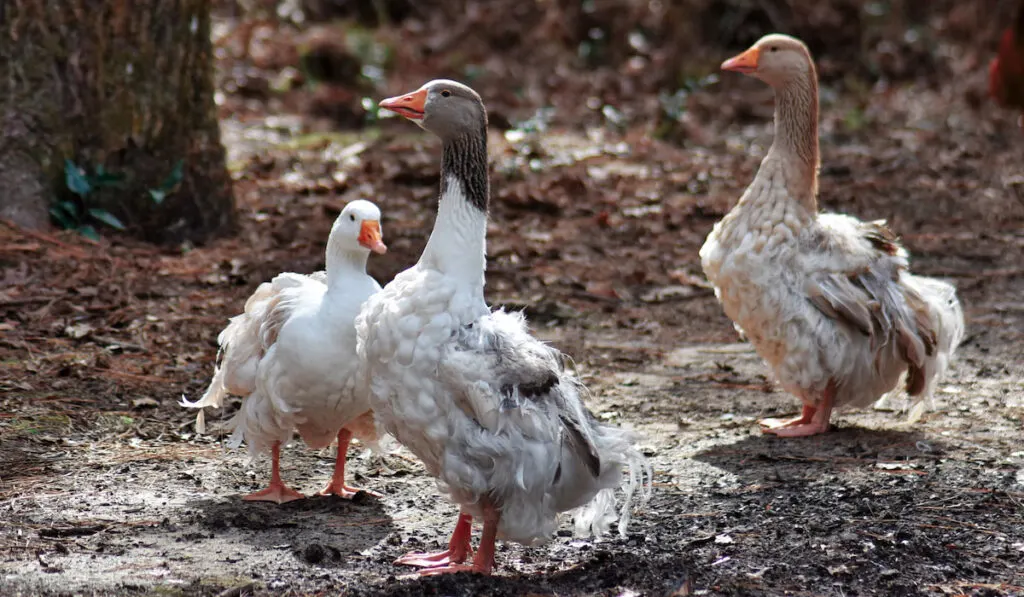
Does the Sebastopol Goose Need a Coop?
Yes, a Sebastopol goose needs a coop.
A coop helps protect the goose from predators, as this bird is not a great flyer. It can fly, but not as high or far as other breeds with lighter and shorter feathers.
In the wild, the Sebastopol goose is more likely to be hunted by large predators, such as wolves, coyotes, bobcats, and feral dogs.
Meanwhile, the domesticated goose is vulnerable to smaller predators that can sneak past tight structures or dig their way into their housing, such as weasels and foxes.
Be sure to build a coop with small holes. However, you want to ensure the coop is large enough and well-ventilated.
Excessive heat can cause discomfort and other health issues to the Sebastopol goose. The best rule of thumb to follow when building a coop is to allow six square feet per bird.
If you live in a cold region, don’t forget to insulate the coop to keep your geese warm and healthy.
Final Thoughts
The Sebastopol goose has become one of the favorite domesticated breeds for farmers and homesteaders.
In addition to its distinctive appearance, this species is also warm and friendly. You won’t have issues raising this goose with other animals.
Resources
- https://petkeen.com/sebastopol-goose/
- https://www.thehappychickencoop.com/sebastopol-goose-all-you-need-to-know/
- https://livestockconservancy.org/heritage-breeds/heritage-breeds-list/sebastopol-goose/
- https://www.mcmurrayhatchery.com/sebastopol.html
- https://www.beardsleyzoo.org/sebastopol-goose.html
- https://www.waterfowl.org.uk/domestic-waterfowl/domestic-geese/light-geese/sebastopol-goose/
- https://www.metzerfarms.com/sebastopol-geese.html
- https://www.roysfarm.com/sebastopol-goose/
- https://learnpoultry.com/sebastopol-geese/
- https://theforestguild.com/our-chickens/sebastopol-geese/
- https://kidadl.com/facts/animals/sebastopol-geese-facts
- https://www.chickens.allotment-garden.org/keeping-geese/geese-diseases-parasites-worms-lice-mites/
- https://opensanctuary.org/common-goose-health-issues/
